11.11.2020
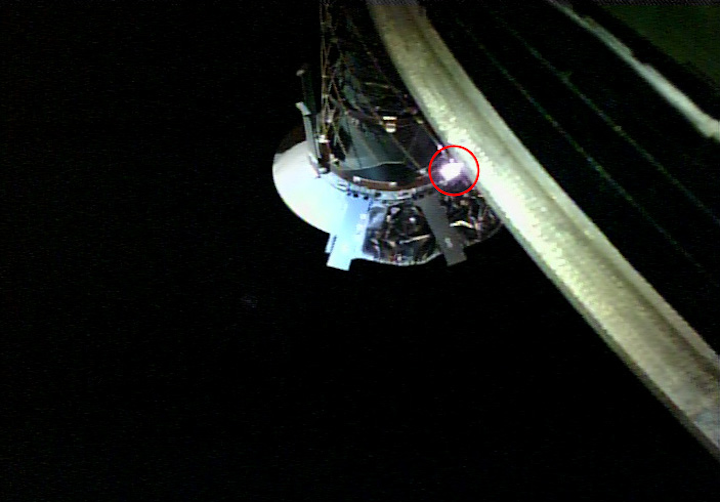
The sampler horn on Hayabusa2 captured with the Small Monitor Camera on August 14, 2018.
The shiny part in the red circle is the target plate of the sampler horn which is irritated with the LRF-S2 laser
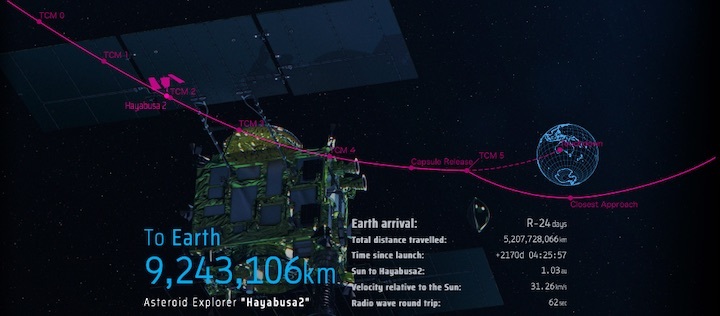
Es gelang, den Asteroiden Ryugu im Bisei Space Guard Center zu beobachten 6. November 2020 (2. Jahr von Reiwa)Nationale Forschungs- und Entwicklungsgesellschaft Organisation für Luft- und Raumfahrtforschung und -entwicklungIm JAXA Bisei Space Guard Center in der Stadt Ihara, Präfektur Okayama, gelang es uns, den von Hayabusa 2 erkundeten Asteroiden Ryugu zu beobachten. Ryugu nähert sich jetzt der Erde und die Helligkeit von Ryugu betrug zu dieser Zeit etwa 16,7 Grad. "Hayabusa 2" verließ Ryugu im November 2019 und segelt weiterhin reibungslos in Richtung Erde. Die Wiedereintrittskapsel wird am 6. Dezember dieses Jahres auf die Erde zurückkehren. Auf der anderen Seite wird sich Ryugu Ende Dezember in einer Entfernung von etwa 9 Millionen km der Erde nähern und sich von ihr entfernen.
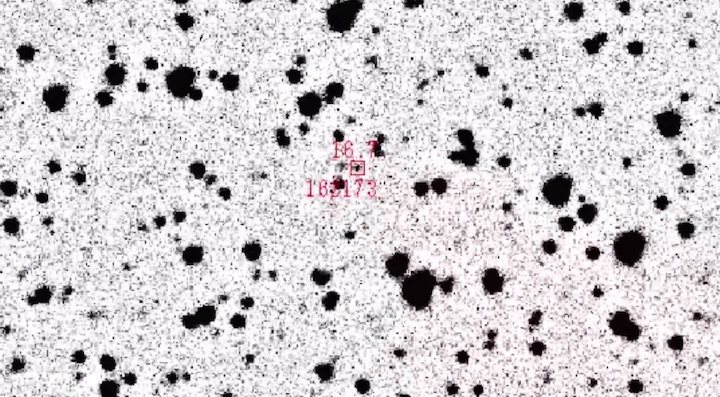
美星スペースガードセンターで小惑星Ryuguの観測に成功
2020年(令和2年)11月6日
国立研究開発法人宇宙航空研究開発機構
岡山県井原市のJAXA美星スペースガードセンターで、「はやぶさ2」が探査した小惑星Ryugu(リュウグウ)の観測に成功しました。リュウグウは現在地球に近づきつつあり、この時のリュウグウの明るさは約16.7等級でした。
「はやぶさ2」は2019年11月にリュウグウを出発し、地球へ向けて順調に航行を続けています。今年の12月6日には、再突入カプセルが地球に帰還する予定です。一方、リュウグウは12月末に地球から約900万kmの距離まで接近し、また離れていきます。
+++
The orbit of Hayabusa2 from launch to just before returning to Earth (TCM-3)
The orbit of Hayabusa2 from launch to just before returning to Earth (TCM-3) has been released: 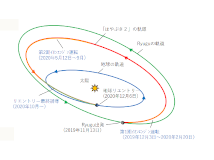
Hayabusa2 orbit information : hayabusa2_orbit_20201021e
The period covered by the data is from the launch of Hayabusa2 on December 3, 2014, through to just prior to the spacecraft’s return to Earth (before TCM-3) on November 25, 2020. The released data has an orbit accuracy of 1000 km. Please use this when creating figures and CG, as well as for teaching materials concerning the trajectory of Hayabusa2 to Ryugu. This data should be sufficiently accurate to create a bird’s eye view of the Solar System and to plot the position of the spacecraft on a star chart. Do note that this data cannot be used for more accurate discussions.
The data is explained below.
Each row of data begins with the date and time given in UTC, where UTC is the “Coordinated Universal Time”. To convert to Japan time, add nine hours to the UTC time. In addition, the following column labelled “L+” gives the total date counted from the launch date. Here, “L” stands for “launch”.
The next nine columns give coordinate values (x, y, z) of Hayabusa2, Earth and Ryugu. The values are written in kilometers. This is the coordinate value based on the ecliptic coordinate system. Since the x-y plane of the coordinate system almost coincides with the orbital plane of the Earth (the ecliptic plane), when drawing the orbit of a celestial body that is not far from the Earth’s orbital plane (i.e. the value of z remains small), you can understand the orbit by plotting only on the x-y plane. (For a detailed explanation of the ecliptic coordinate system, please refer to a book on celestial orbits.)
The following values are also listed:
Rs: Distance between Hayabusa2 and the Sun
Re: Distance between Hayabusa2 and the Earth
Ra: Distance between Hayabusa2 and Ryugu
Vs: Cruising speed of Hayabusa2 (relative to the velocity of the Sun)
Ve: Relative speed of Hayabusa2 to the Earth
alpha: Right ascension of Hayabusa2 as seen from the Earth
delta: Declination of Hayabusa2 as seen from the Earth
Dflt: Total flight distance of Hayabusa2
We hope this orbital data will allow you to enjoy Hayabusa2’s journey even more!
Hayabusa2 Project
2020.10.21
Quelle: JAXA
----
Update: 19.11.2020
.
The TCM-2 operation
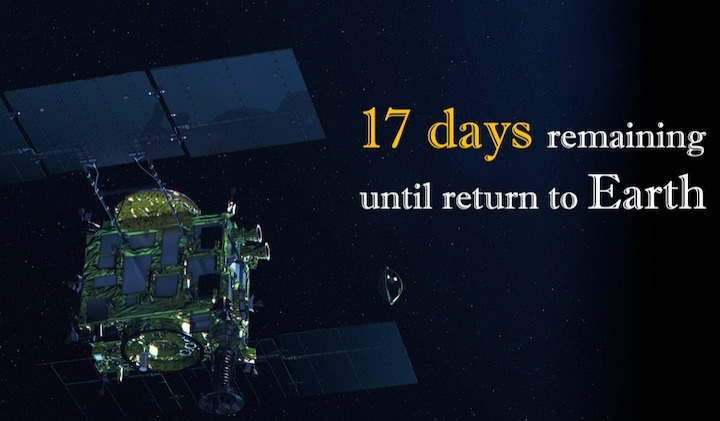
Four further TCMs are planned. The first of these is TCM-2, which will perform a minute orbit correction on November 12. The most important is TCM-3, which puts the spacecraft into a collision orbit with the Earth and will be held in late November. Its correction, TCM-4, will then take place in early December. The re-entry capsule will be separated from the spacecraft from 14:00 – 15:00 JST on December 5. Immediately after this, TCM-5 will be performed and the spacecraft will leave the Earth’s geosphere. The landing of the capsule in Woomera is scheduled for December 6, 02:00 – 03:00 JST.
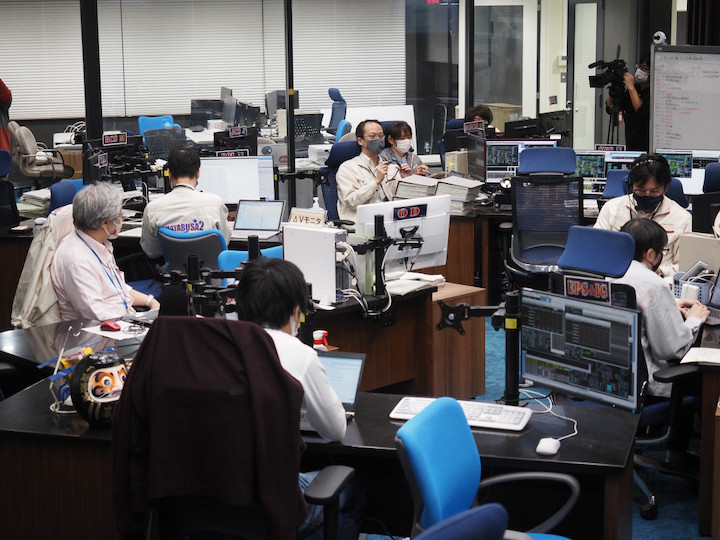
Quelle: JAXA
+++
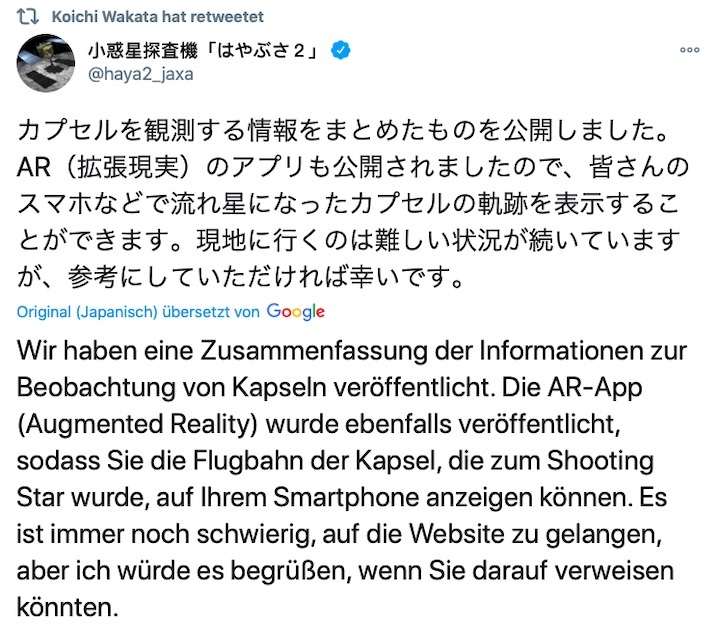
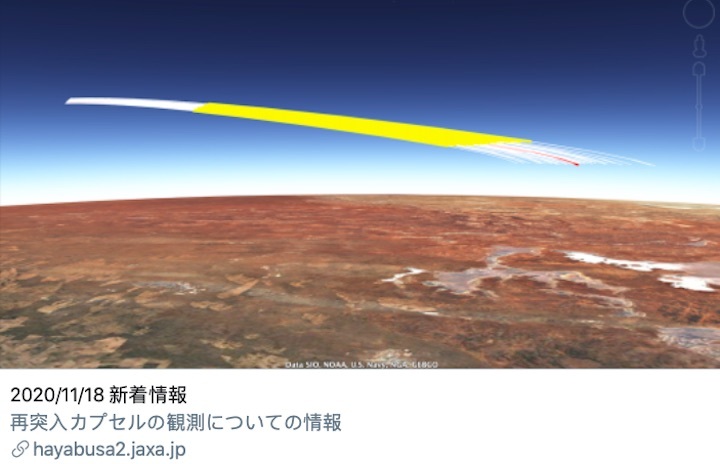
Quelle: Twitter
----
Update: 23.11.2020
.
Astronomy: Fragments of asteroid due to land in outback in 2020 thanks to Japan Aerospace Exploration Agency's Hayabusa2
Pieces of an asteroid are currently hurtling through space towards the Earth.
They're headed straight for the Australian outback, and they're due to land on Sunday, December 6.
They've come from an ancient asteroid, older than the planets themselves, and in past eras, objects like it helped make the Earth into the living planet it is today.
Those pieces of an asteroid are safely stored inside a spacecraft, the Japan Aerospace Exploration Agency (JAXA) Hayabusa2.
If all goes to plan, their impact onto the Woomera Testing Range will be a gentle one.
It will be the second time anybody has successfully returned a sample from an asteroid, and the first time one will be returned from an asteroid rich in water and the carbon-based building blocks of life known as organics.
The target asteroid had been unmemorably named 1999 JU3, but it's since been dubbed Ryugu, after a dragon's underwater palace from Japanese folklore.
In the story, a fisherman is taken to Ryugu by a turtle and returns with treasure from the ocean palace, much like Hayabusa2 from our asteroid. If it's a palace though, it's one in ruins. Ryugu appears to be a "rubble-pile" roughly 900m across, an assemblage of boulders only just holding itself together.
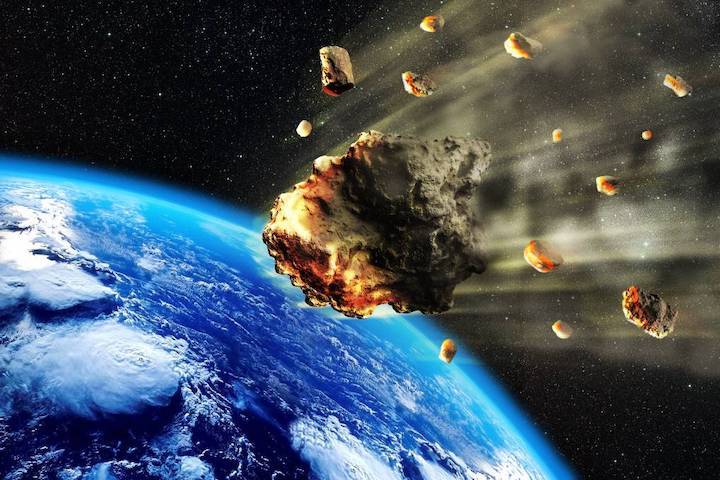
An illustration of asteroids heading towards Earth. Pieces of an asteroid safely stored inside spacecraft Hayabusa2 are due to land next month. Picture: Shutterstock
Asteroids like it are thought to have originally been part of larger worlds formed from a mixture of ice and rock (i.e. mud), beyond the present-day asteroid belt. But if they formed all the way out there, what could they have to do with the Earth's history?
The gravity of the gas giants, Jupiter and Saturn, sculpts the orbits of objects around them like fingers in spinning clay, gathering clusters of tiny worlds here, emptying regions of space there.
When the Solar System first formed, the orbits of the gas giants were still shifting and as they moved they flung many water-rich worlds into the inner planets.
Exactly how much of the Earth's water arrived this way is still debated, but it may well be that most of our oceans, clouds, and rivers owe their presence on Earth to asteroids like Ryugu.
They also helped deliver the oily organics, that stuff that would become life, to the inner Solar System.
In meteorites thought to be similar to Ryugu, organic chemicals as complex as amino acids can be found.
That doesn't mean life began on asteroids, but the ingredients of life as we know it were raining down on Earth, Mars, and Venus very shortly after they formed.
The gas giants still fling rocks from the asteroid belt at us, although much less often these days.
The giants squeeze asteroid orbits until they begin to pass close by the Earth, where they become known as near-Earth asteroids (NEAs) and, if they actually hit the Earth, then they're called meteorites.
Exactly where in the asteroid belt the different meteorite types come from is still an open question, but sample return missions like Hayabusa2 will help answer exactly that, helping us to build a geological map of the Solar System.
Hayabusa2 is set to pass close by the Earth on December 6.
It will jettison its sample return case, which will land in Woomera to be picked up by Japanese and Australian scientists.
This treasure trove from Ryugu will reveal fascinating insights into the history of the Solar System, the Earth, and the beginnings of life itself.
- Geoff Bonning is a PhD Candidate in Cosmochemistry at the Research School of Earth Sciences at the ANU
Quelle: THE CANBERRA TIMES
----
Update: 24.11.2020
.
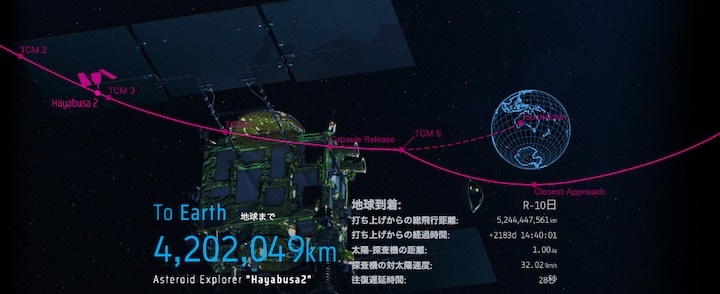
Information on observing the
re-entry capsule.

Here is information compiled for observing the re-entry capsule as it returns to Woomera, Australia. Trinigen have also released an app (supervised by JAXA) called “Reentry AR” that displays the predicted trajectory of the re-entry capsule viewed from any location in AR (augmented reality). This can be downloaded for free, so please try this out.
Unfortunately, protections against the new coronavirus have restricted travel to Australia. But we hope you can imagine our re-entry, even if it is not possible to travel to view the capsule.
Reentry AR Download site
QR Code
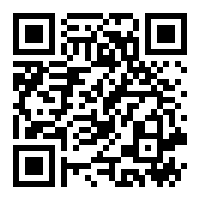
Japanese
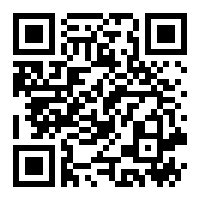
English










Quelle: JAXA
----
Update: 28.11.2020
.
Japan spacecraft carrying asteroid soil samples nears home
A Japanese spacecraft is nearing Earth after a yearlong journey home from a distant asteroid with soil samples and data that could provide clues to the origins of the solar system
TOKYO -- A Japanese spacecraft is nearing Earth after a yearlong journey home from a distant asteroid with soil samples and data that could provide clues to the origins of the solar system, a space agency official said Friday.
The Hayabusa2 spacecraft left the asteroid Ryugu, about 300 million kilometers (180 million miles) from Earth, a year ago and is expected to reach Earth and drop a capsule containing the precious samples in southern Australia on Dec. 6.
Scientists at the Japan Aerospace Exploration Agency believe the samples, especially those taken from under the asteroid's surface, contain valuable data unaffected by space radiation and other environmental factors.
Makoto Yoshikawa, a Hayabusa2 project mission manager, said scientists are especially interested in analyzing organic materials in the Ryugu soil samples.
“Organic materials are origins of life on Earth, but we still don(asterisk)t know where they came from,” Yoshikawa said. “We are hoping to find clues to the origin of life on Earth by analyzing details of the organic materials brought back by Hayabusa2."
JAXA, the space agency, plans to drop the capsule containing the samples onto a remote, sparsely populated area in Australia from 220,000 kilometers (136,700 miles) away in space, a big challenge requiring precision control. The capsule, protected by a heat shield, will turn into a fireball during re-entry in the atmosphere at 200 kilometers (125 miles) above ground. At about 10 kilometers (6 miles) above ground, a parachute will open to prepare for landing, and beacon signals will be transmitted to indicate its location.
JAXA staff have set up satellite dishes at several locations in the target area to catch the signals, while also preparing marine radar, drones and helicopters to assist in the search and retrieval mission.
Without those measures, a search for the pan-shaped capsule with a diameter of 40 centimeters (15 inches) "would be an extremely difficult," Yoshikawa told reporters.
For Hayabusa2, it’s not the end of the mission it started in 2014. After dropping the capsule, it will return to space and head to another distant small asteroid called 1998KY26 on a journey slated to take 10 years.
Hayabusa2 touched down on Ryugu twice, despite its extremely rocky surface, and successfully collected data and samples during the 1½ years after it arrived there in June 2018.
In the first touchdown in February 2019, it collected surface dust samples. In July, it collected underground samples from the asteroid for the first time in space history after landing in a crater that it had earlier created by blasting the asteroid’s surface.
Scientists said there are traces of carbon and organic matter in the asteroid soil samples. JAXA hopes to find clues to how the materials are distributed in the solar system and are related to life on Earth.
Asteroids, which orbit the sun but are much smaller than planets, are among the oldest objects in the solar system and therefore may help explain how Earth evolved.
It took the spacecraft 3½ years to arrive at Ryugu, but the journey home was much shorter because of the current locations of Ryugu and Earth.
Ryugu in Japanese means “Dragon Palace,” the name of a sea-bottom castle in a Japanese folk tale.
Quelle: abcNews
----
Update: 1.12.2020
.
Scientists prepare to collect asteroid sand sample
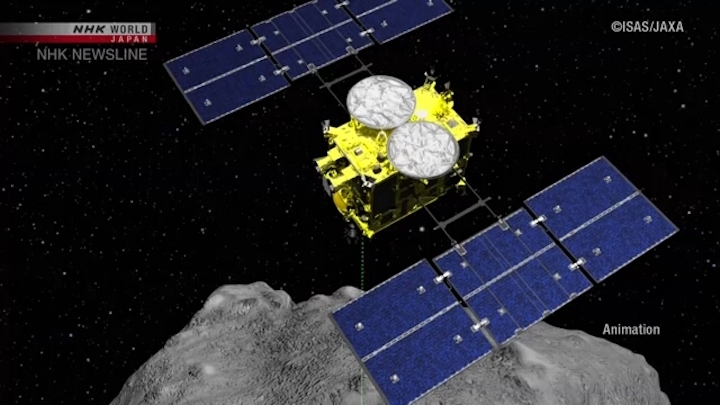
Scientists are making final preparations to retrieve a capsule from a Japanese space probe that went to collect sand from an asteroid.
Japan's space agency, JAXA, launched Hayabusa2 in 2014. It has twice landed on an asteroid called Ryugu about 340 million kilometers from Earth.
As of Monday morning, the probe was moving at about four kilometers per second, roughly 2.3 million kilometers from home.
Scientists plan to make a final course adjustment on Tuesday. On December 5, Hayabusa2 is scheduled to release a capsule that researchers believe contains sand from the asteroid. The capsule is due to land in an Australian desert on December 6.
A team of researchers arrived in southern Australia on November 24. They are preparing to track the capsule by radar and collect it.
The capsule will be flown to Japan and its contents will be divided by researchers after an initial analysis. Their study could provide clues about how the solar system was formed, as well as the origin of water and life on Earth.
After releasing the capsule, Hayabusa2 will change course and begin a new 10-year mission to explore another asteroid.
Quelle: NHK
+++
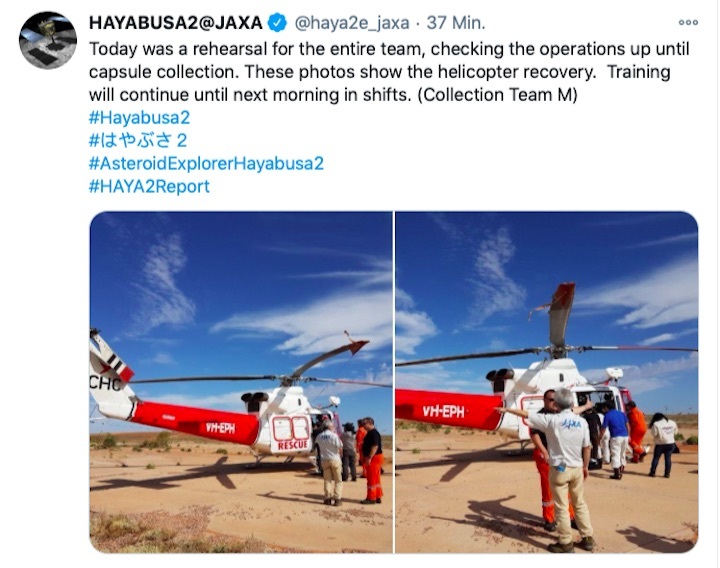
Quelle: Twitter
----
Update: 2.12.2020
.
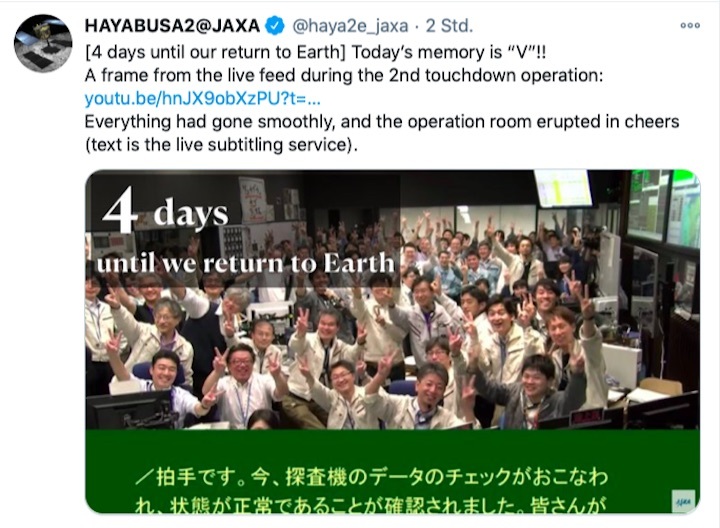
Quelle: Twitter
----
Update: 4.12.2020
.
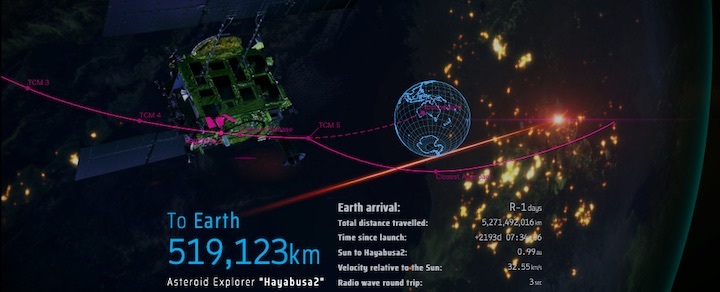
Quelle: JAXA
+++
Capsule collection:
Search for the re-entry capsule.
The expected landing area for the capsule covers over a 100 kilometer-squared region. This large space could accommodate multiple Tokyo metropolitan areas, but then the separation of the capsule was performed at a distance of about 220,000 km from the Earth. Since the distance to the Moon is about 380,000 km, this is the equivalent of throwing a ball from more than half the distance to the Moon to a 100 km-sq spot in Australia, so the control is really great.
However, a capsule on the ground in the dark will be very difficult to find. Therefore, we will search for the beacon signal, as mentioned in the previous article. Five antennas will be installed around the expected landing site, which will each record the direction of the signal. These directions will be reported to the headquarters and when plotted on a map, the intersection will reveal the position of the signal source (principal of triangulation). This method is the same as used for Hayabusa, but for Hayabusa2, considering the area we needed to cover and potential troubles, we decided to increase the number of stations by one and search with a total of five stations.
But even when the signal source is identified by a ground station, its location can only be narrowed down to a few kilometres square. Additionally, the capsule may be hidden from a ground station by the horizon and that station would be unable to receive the signal after the landing. Therefore, a helicopter is also equipped with a beacon receiver.

Backup capsule search method
While we hope everything will go well, we have also prepared for problems to arise. For Hayabusa2, we introduced some additional methods that can be used to search for the capsule. One of these is marine radar. The capsule is too small to detect by this method, but the parachute can be located. This can be searched for even if the beacon signal is not being emitted due to a problem. For this method, four stations will be deployed around the expected landing area.

Also, as with Hayabusa, optical observations of the light emitted during re-entry will be performed. The direction of the emitted light can be measured from multiple locations to determine the re-entry trajectory using the principal of triangulation. If the sky is cloudy, then this will not be possible to measure so we will also observe by aircraft. By extending the orbit of the trajectory, you can predict the landing point by assuming that the wind has little effect. If there is an abnormality during the heat shield separation, the parachute will not open and no beacon signal will be transmitted, so the results of the optical observations will be the most reliable.

Hayabusa2 will also introduce a drone search. The drone can fly at a programmed latitude and longitude and take a continuous sequence of pictures. If none of the previous methods have worked, or if the capsule cannot be found when searching an area, the huge number of photographs from the drone can be analysed to find the capsule.

Work after capsule discovery
Once the capsule is found, it will not be approached immediately. Pyrotechnics are used to open the parachute and separate the heat shield, so first a safety check is needed for any non-ignition. After safety verification and confirming there has been no damage to the capsule or leakage of the sample and with permission from an Australian safety officer, the capsule will be taken to headquarters by helicopter for cleaning and gas sampling in a clean room. Since the sample container may contain a small amount of gas emitted from the Ryugu sample, a simply analysis will be conducted on-site before it is contaminated by the Earth’s atmosphere. If the sample itself is able to be collected before it is oxidized, it will be brought back to Japan by charter flight before the team members. In Australia, the capsule itself will not be opened.
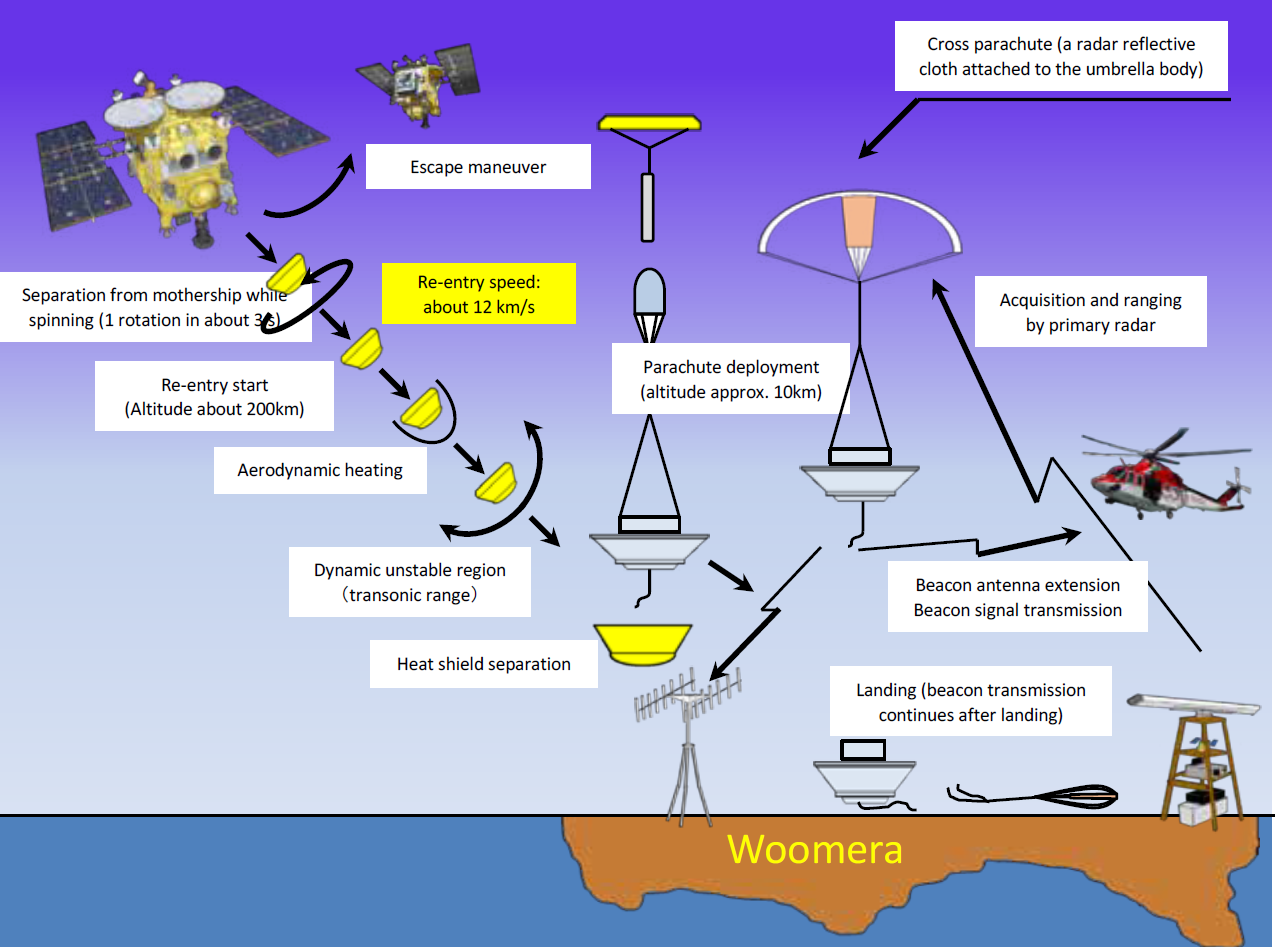
I am anxious and excited about how much sample has been collected, but if we find something in the gas analysis, my expectations for the results will grow greatly. From now on, the on-site work will begin.
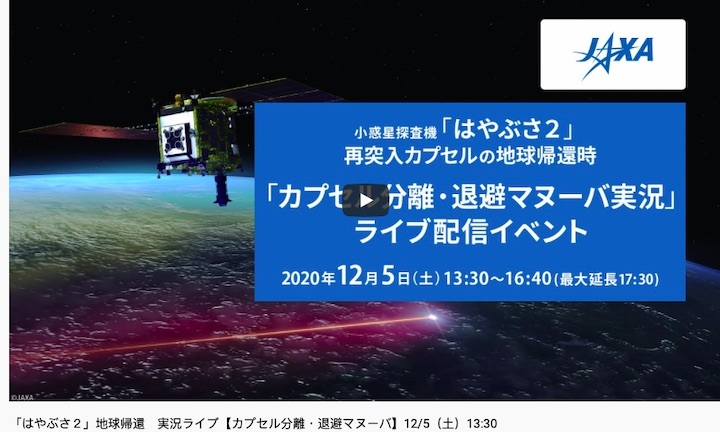
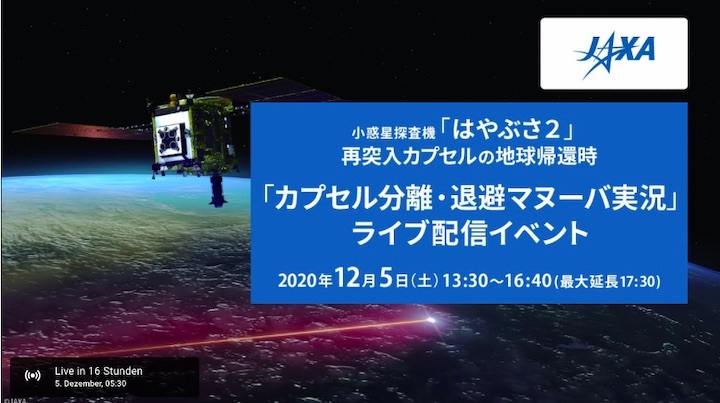
After six years and 6bn km, Japan's Hayabusa2 prepares to bring home cargo of asteroid dust
Japanese craft collected dust from the asteroid Ryugu that scientists hope could shed light on the origins of life
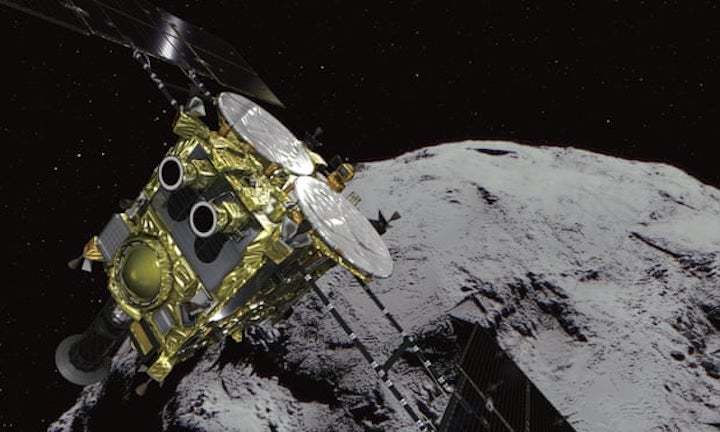
Six years and three days after its groundbreaking mission began, the Japanese spacecraft will drop a capsule onto the Australian outback carrying pristine asteroid fragments that scientists believe could shed light on the formation of the solar system and the origins of life.
By the time it reaches the skies high over Woomera, South Australia, in the early hours of Sunday, the probe will have completed a round-trip of around 6bn km (3.7bn miles) that included two brief stops on the surface of a moving asteroid.
The unmanned craft will release the capsule from a height of about 220,000km (136,700 miles), the Japan Aerospace Exploration Agency (Jaxa) said.
Sunday’s operation will mark the climax of a ¥30bn (£215m) mission that began when Hayabusa2, whose name means falcon in Japanese, left the Tanegashima space centre in south-west Japan in December 2014.
The probe reached its stationary position above the asteroid – named Ryugu after an undersea dragon palace in a Japanese fairy tale – in June 2018 after travelling 3.2bn km on an elliptical orbit around the sun for more than three years.
One of several critical stages of the mission came in February last year, when it briefly landed on Ryugu and fired a tiny tantalum pellet at the asteroid’s surface to kick up dust for collection, before blasting back to its holding position.
Five months later, it achieved a world-first when it landed a second time to collect dislodged rock fragments and soil from beneath the surface of the 4.6bn year-old asteroid.
Jaxa believes those sub-surface samples contain carbon and organic matter that, having been shielded from space radiation and other environmental factors, are in the same state as they were when the solar system was formed.
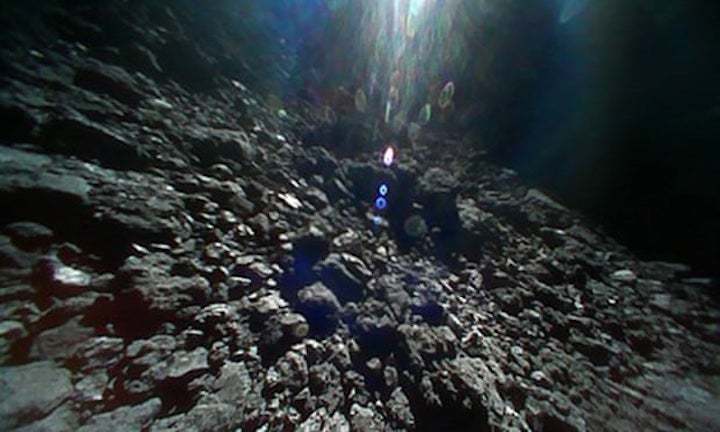
Makoto Yoshikawa, a Hayabusa2 project mission manager at Jaxa, said scientists were especially interested in analysing organic materials in the Ryugu samples.
“Organic materials are the origins of life on Earth, but we still don’t know where they came from,” Yoshikawa said at a briefing. “We are hoping to find clues to the origin of life on Earth by analysing details of the organic materials brought back by Hayabusa2.”
The capsule, protected by a heat shield, will turn into a fireball during re-entry into Earth’s atmosphere at 200km above ground. At about 10km above ground, a parachute will open and, if all goes to plan, the capsule will send out signals indicating its location on the ground.
Jaxa experts, who arrived at Woomera last month, have set up satellite dishes at several places to pick up the signals, while the Australian spaceagency and the Department of Defence will be on standby to help in the search and retrieval mission.
Without local assistance, the search for the capsule, which is just 40cm in diameter, “would be extremely difficult”, Yoshikawa said.
Hayabausa2’s work will not yet be done at that point, however. After releasing the capsule, it will head for another distant asteroid, named 1998KY26, in a mission that is expected to last a decade.
Quelle: The Guardian
----
Update: 5.12.2020 / 8.35MEZ
.
Rückkehr von JAXA´s Asteroid Explorer Hayabusa-2 von Asteroid 1999 JU3
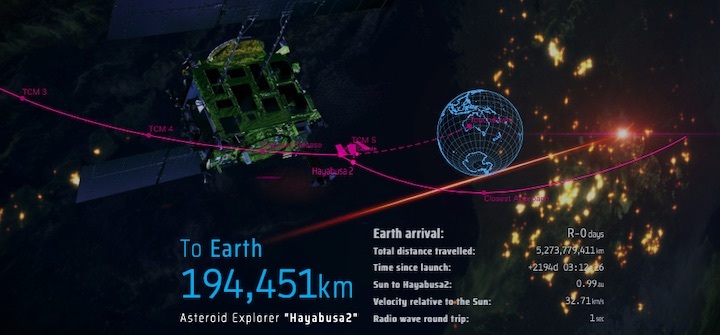
Quelle: JAXA
+++
Update: 10.25MEZ
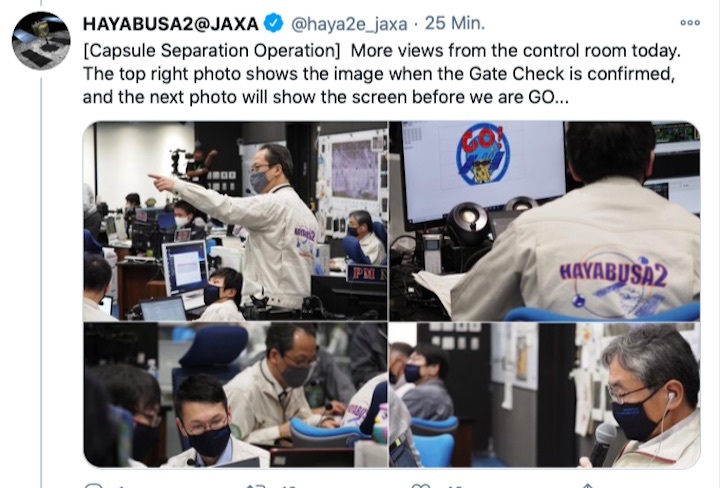
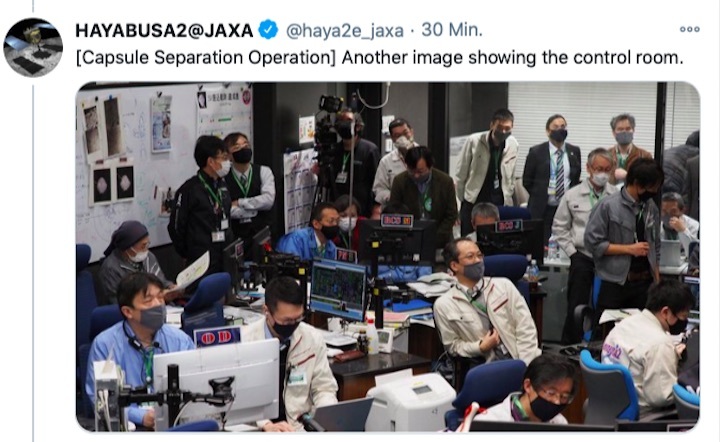
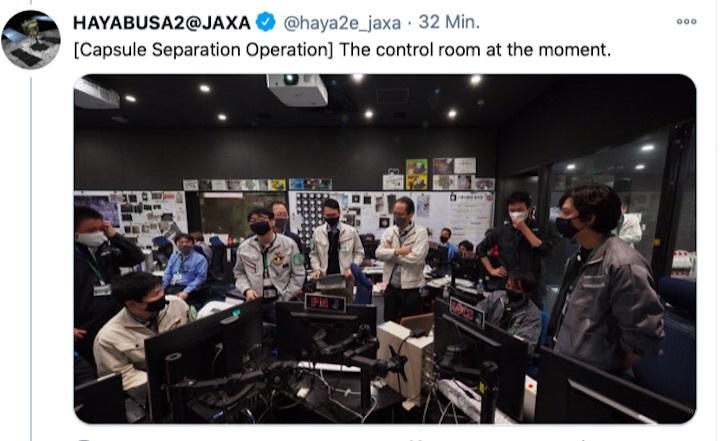
Quelle: JAXA
+++
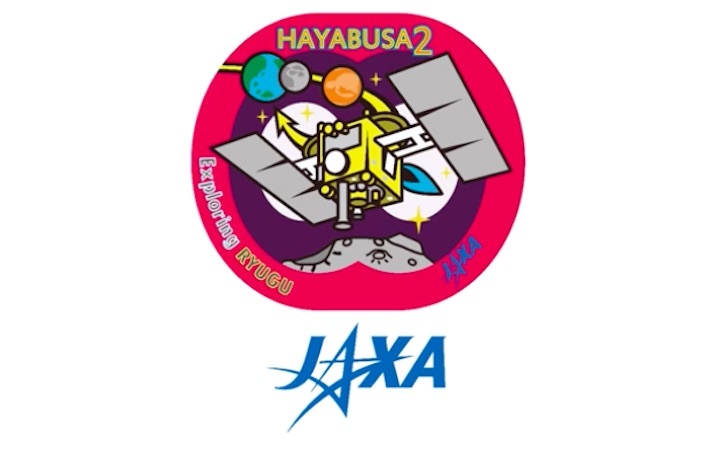
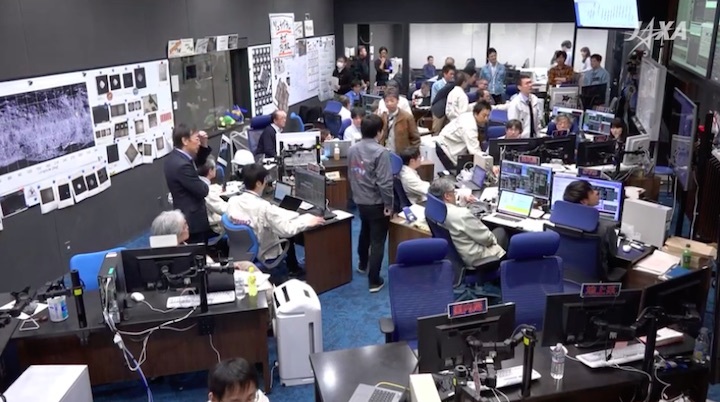
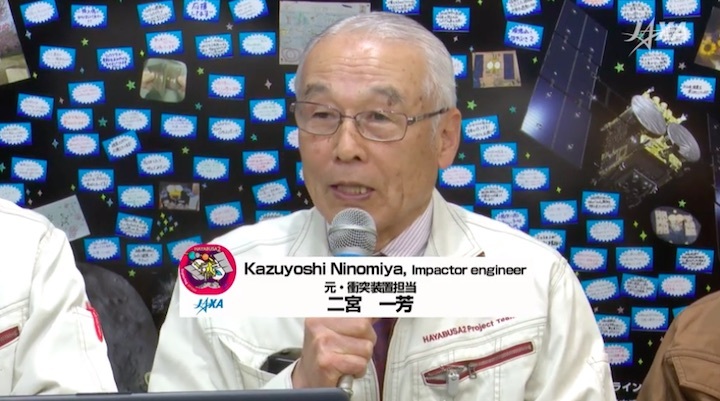
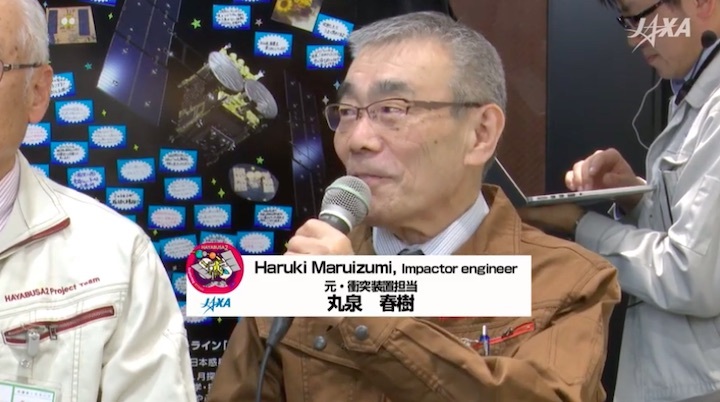

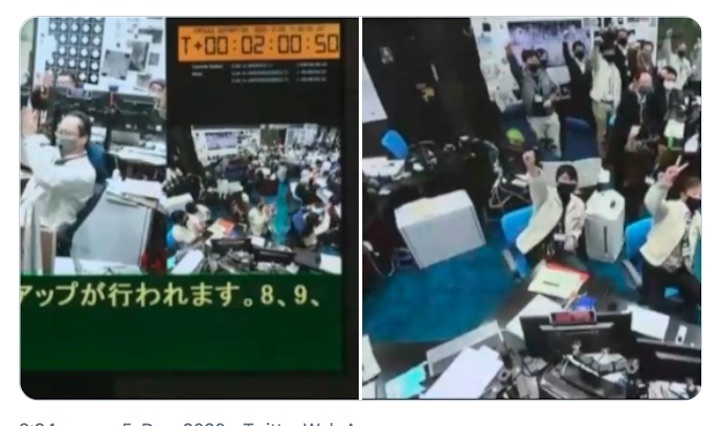
Quelle: JAXA
+++
Update: 15.00MEZ
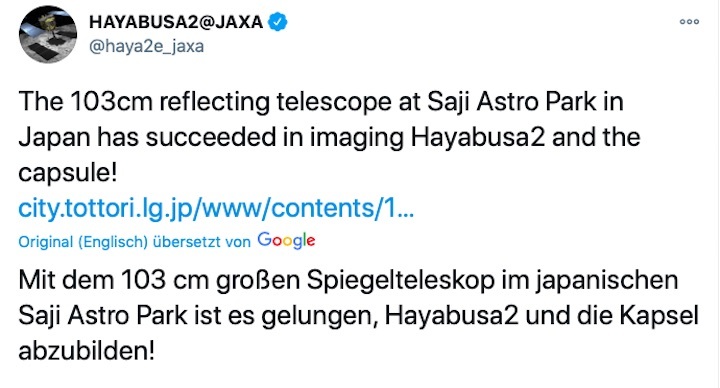
Quelle: Twitter
+++
小惑星探査機「はやぶさ2」と「カプセル」をとらえた!
小惑星「リュウグウ」の砂などが入ったカプセルを地球に送り届けるため、地球に接近している小惑星探査機「はやぶさ2」を、鳥取市さじアストロパークにある103cm反射望遠鏡(愛称:キラット望遠鏡)で、12月5日(土)18時過ぎにとらえました!
そして、その近くに「カプセル」もいることが確認できました!
地球からの距離は約16万km。はやぶさ2本体の明るさは概略での測定で17.3等(V等級)、カプセルの明るさは19.6等(V等級)でした。
これからさらに地球に近づき、日本からは日が変わって6日(日)深夜2時前まで撮影可能です(撮影には少なくともアマチュア天文家クラスの撮影技術が必要です)。これ以降も、鳥取市さじアストロパークでは、はやぶさ2とカプセルの観測を深夜まで続ける予定です。
下の画像は、103cm反射望遠鏡に短焦点化レンズを付け(焦点距離4750mm)、天文用デジタルカメラ(冷却CCDカメラ)で18時30分頃、4分露出で撮影したものです。※本観測は、JAXAはやぶさ2プロジェクト、日本惑星協会、日本公開天文台協会の主催による「おかえりはやぶさ2観測キャンペーン」の一環として実施しています。
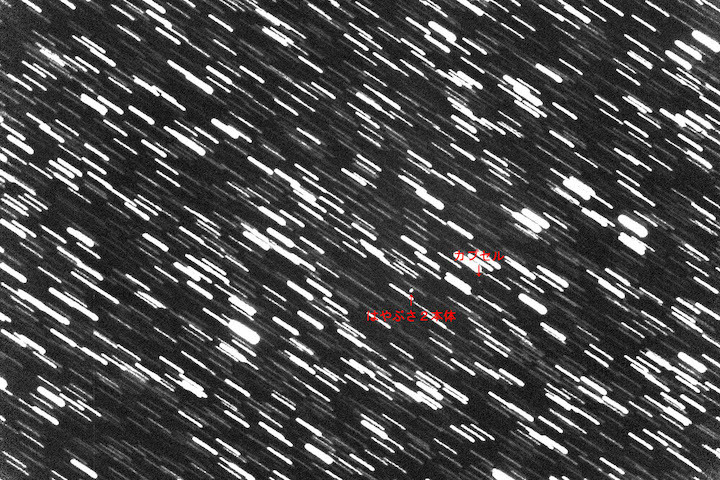
継続して観測中ですが、21時3分に撮影した画像を公開します。はやぶさ2本体とカプセルがだんだん離れてきました。本体は16.8等、カプセルが18.9等でした。
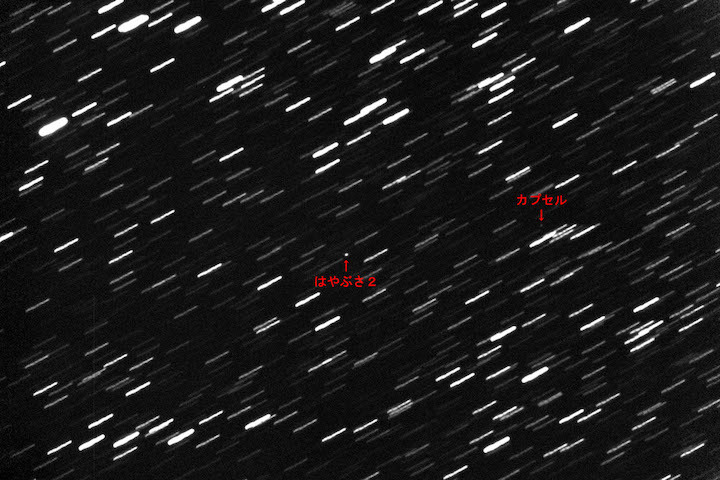
観測を継続していますが、22時3分現在、はやぶさ2本体の明るさが16.2等、カプセルが18.2等です。以下はその時に60秒露出でとらえた画像です。
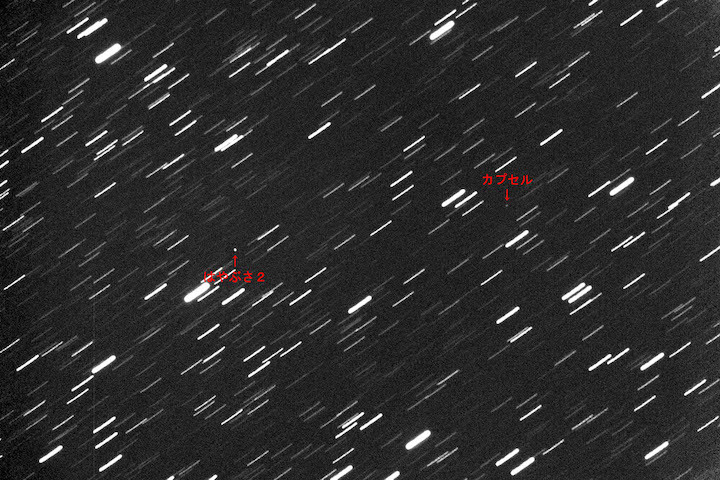
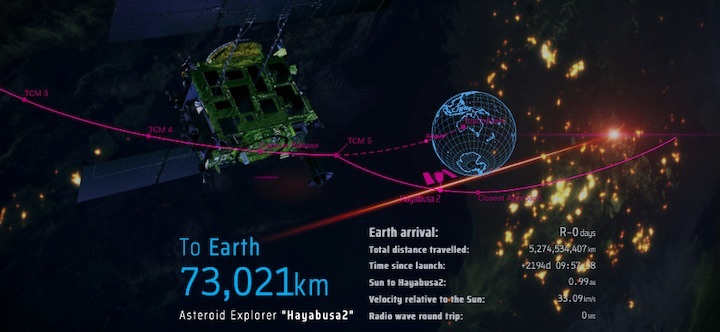
Quelle: JAXA
+++
Update: 20.15MEZ
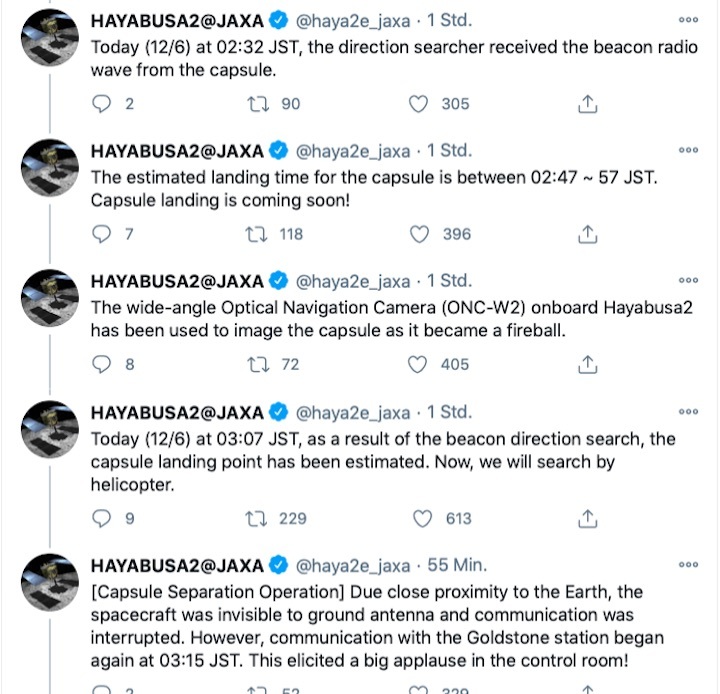
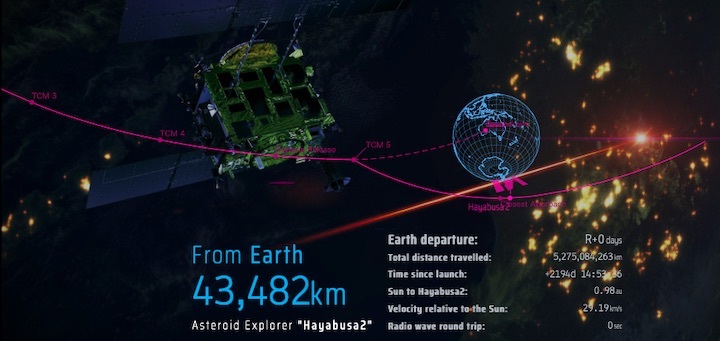
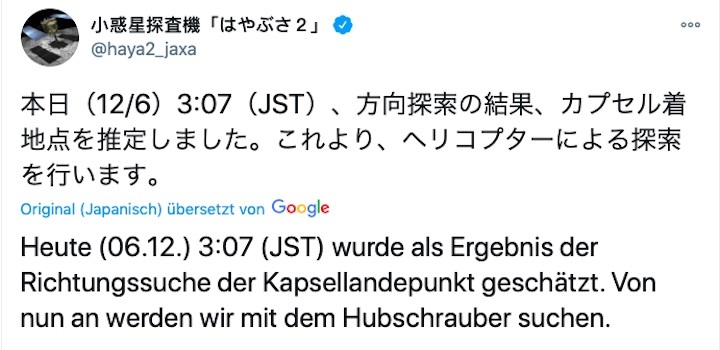
Quelle: JAXA
+++
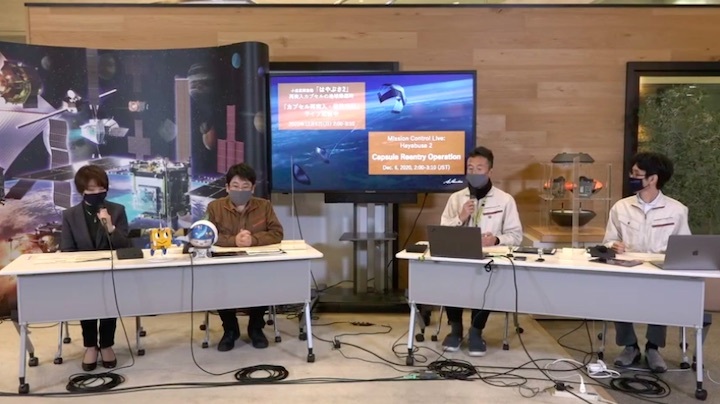
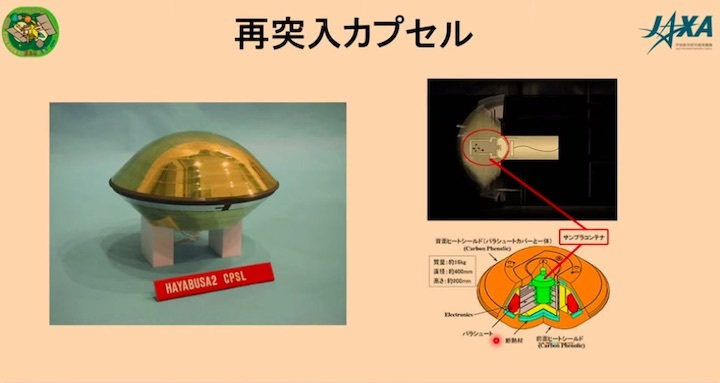
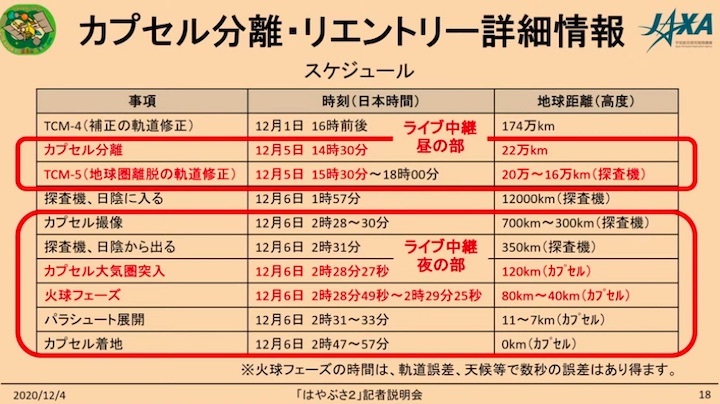
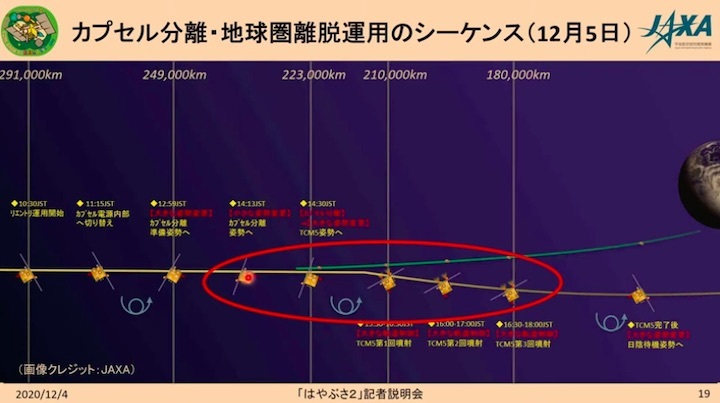
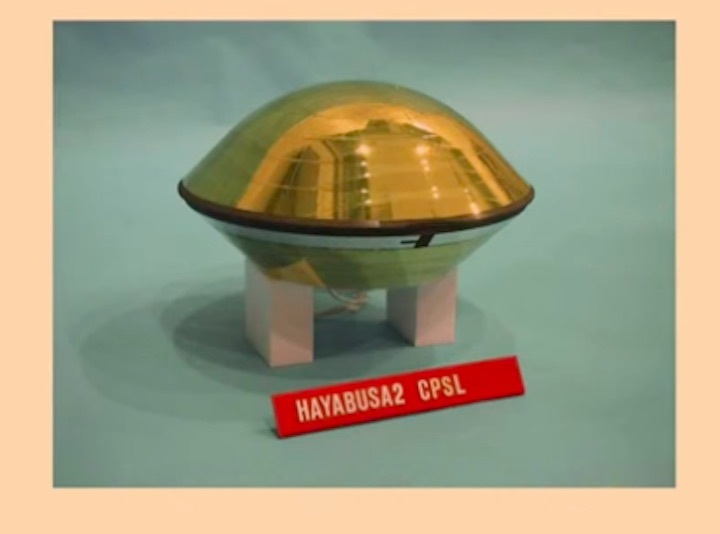
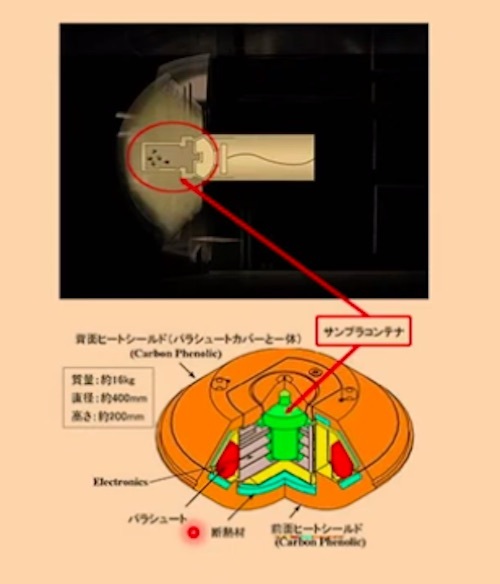
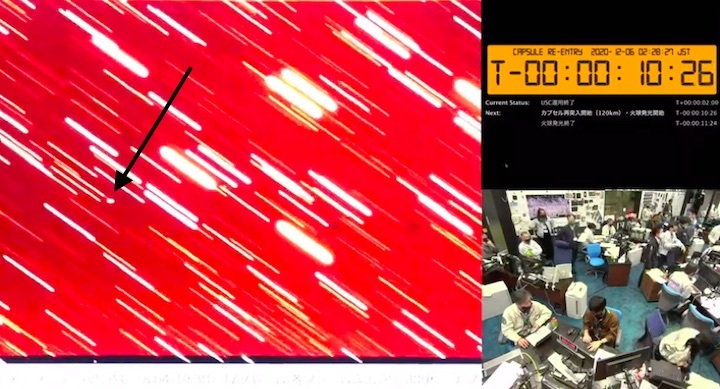
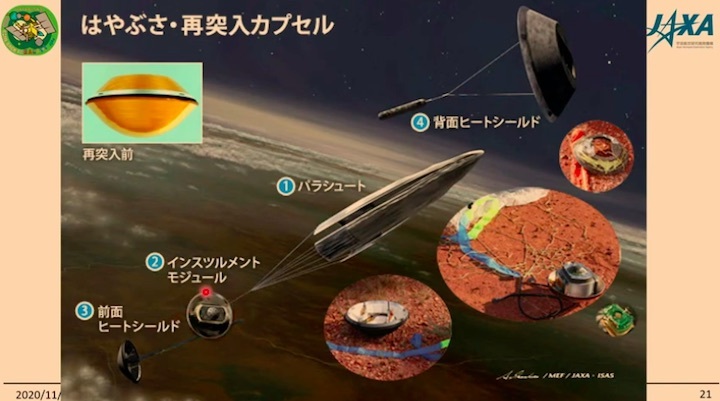
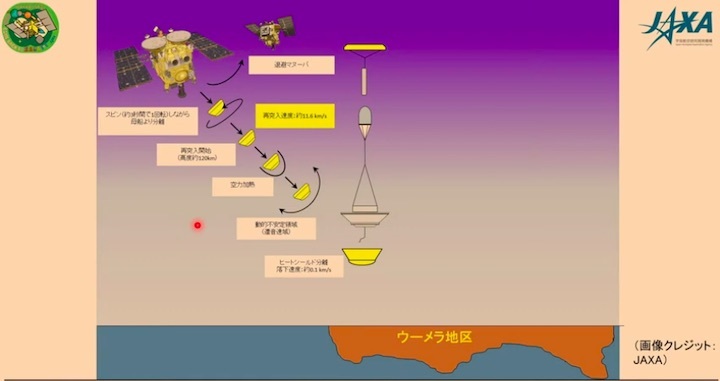
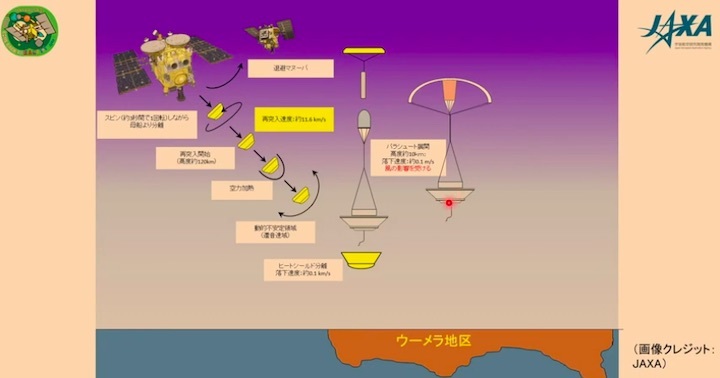
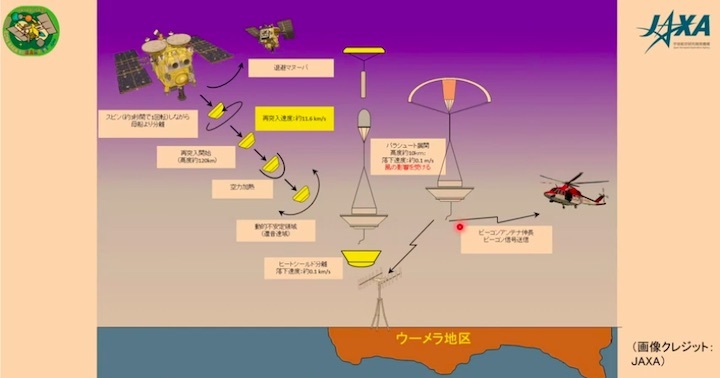
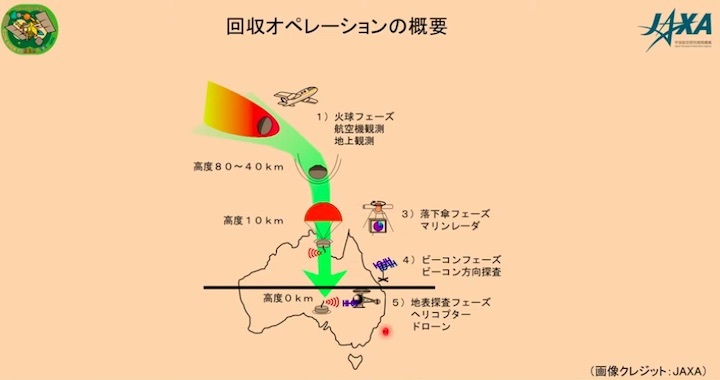
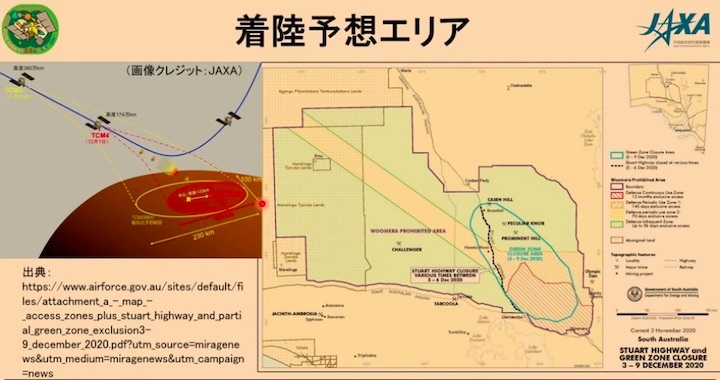
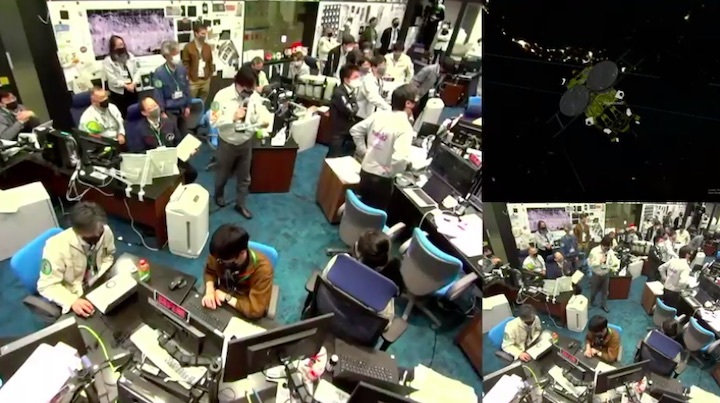
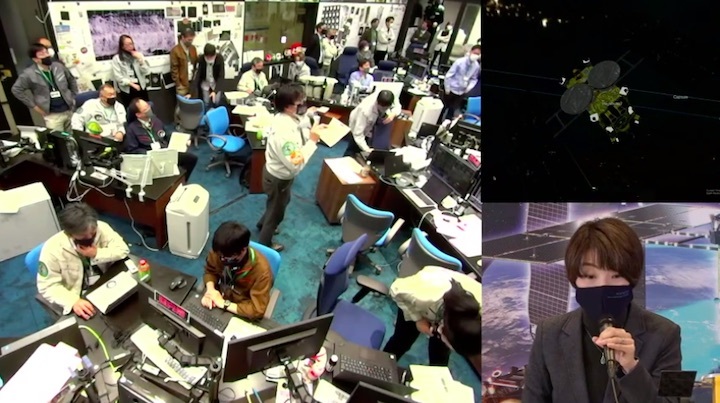
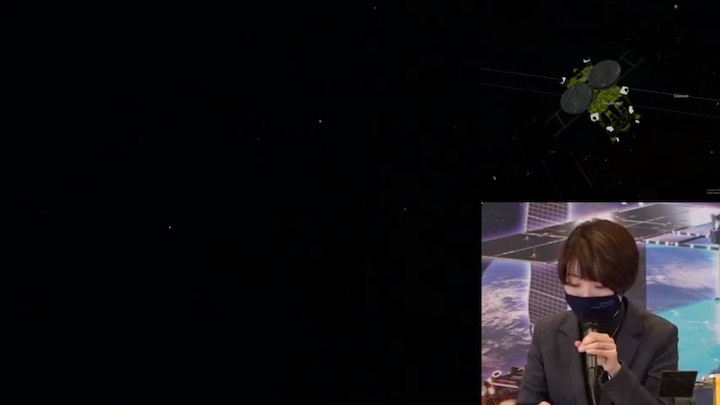
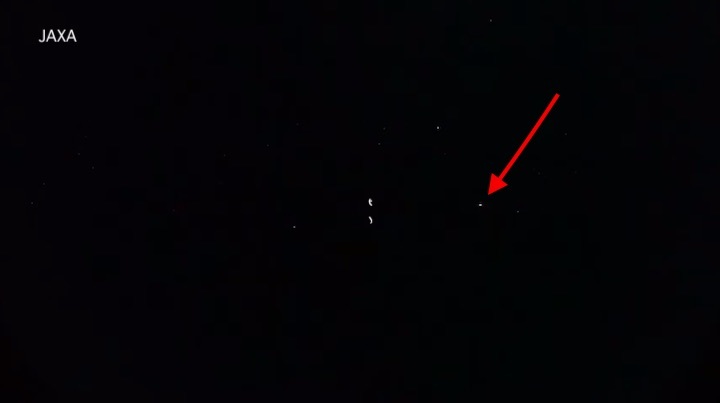
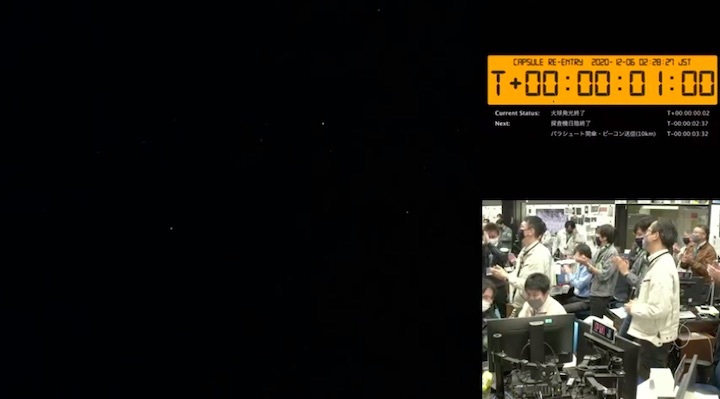
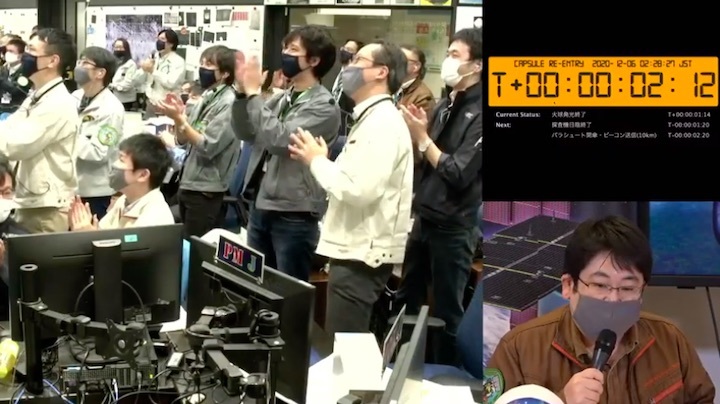
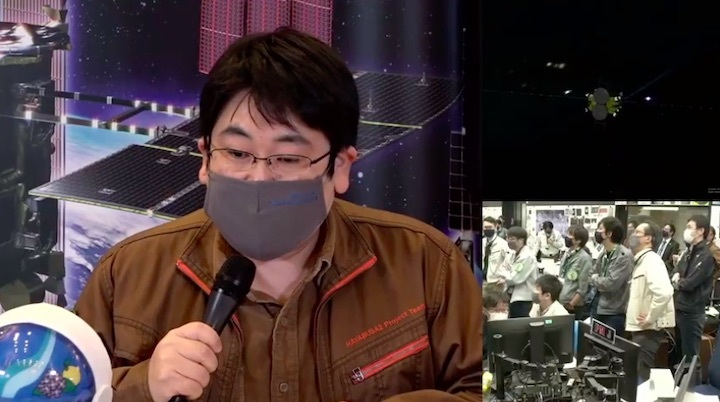
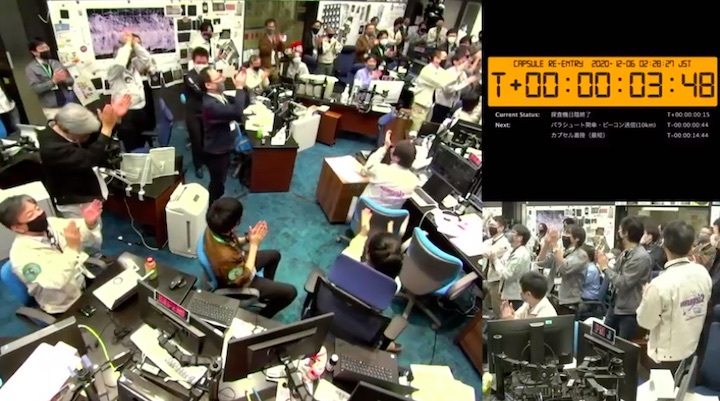
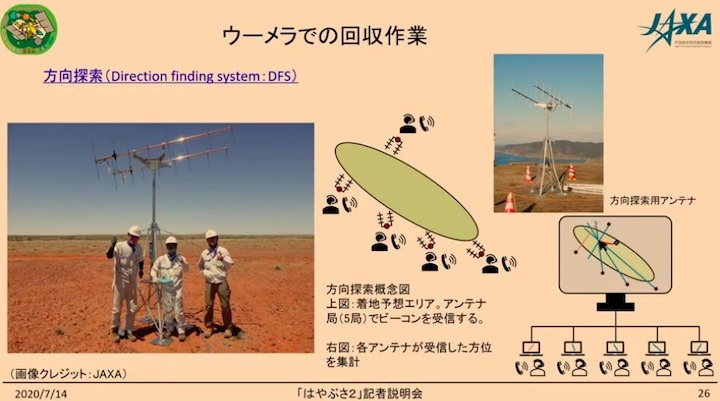
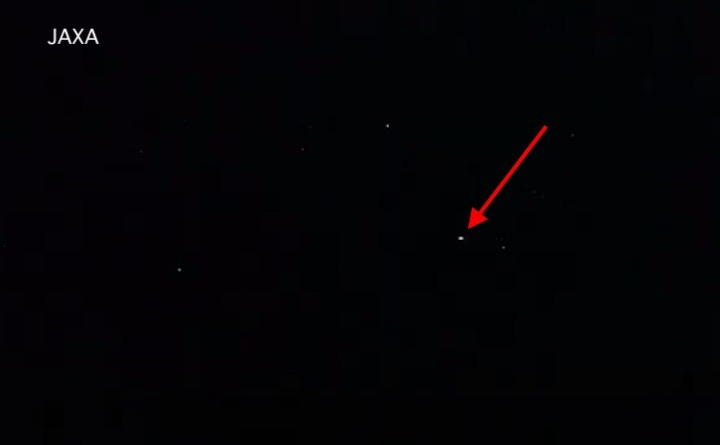



Quelle: JAXA
----
Update; 21.00MEZ
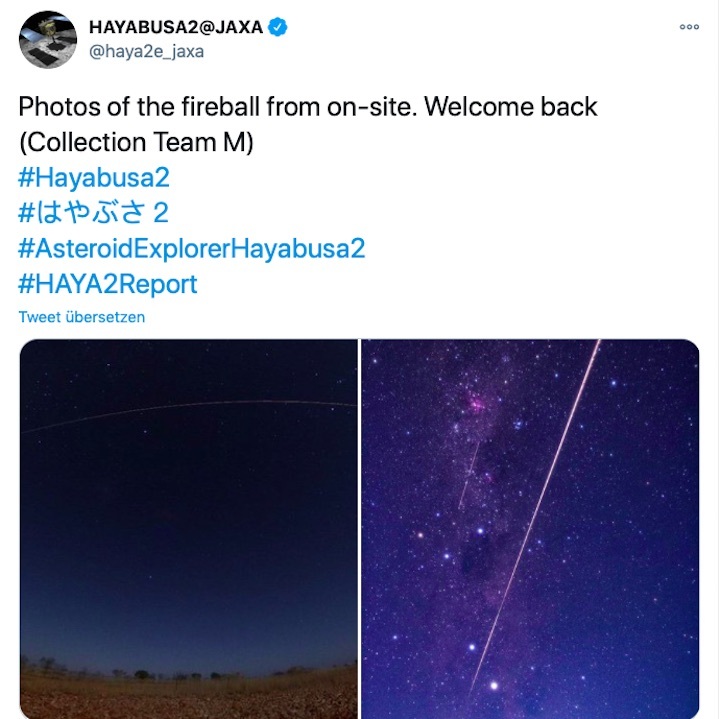
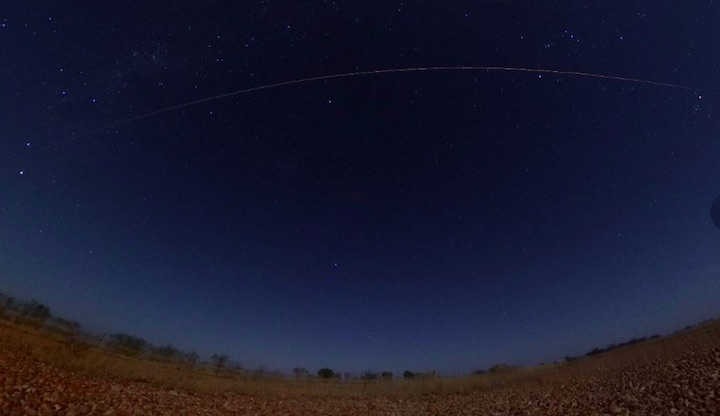
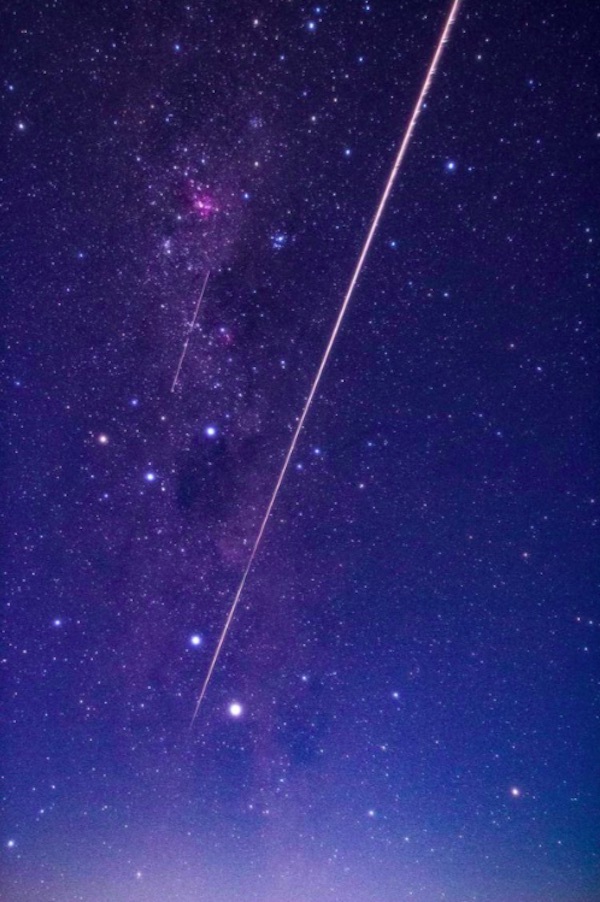

Quelle: JAXA
----
Update: 6.12.2020
.
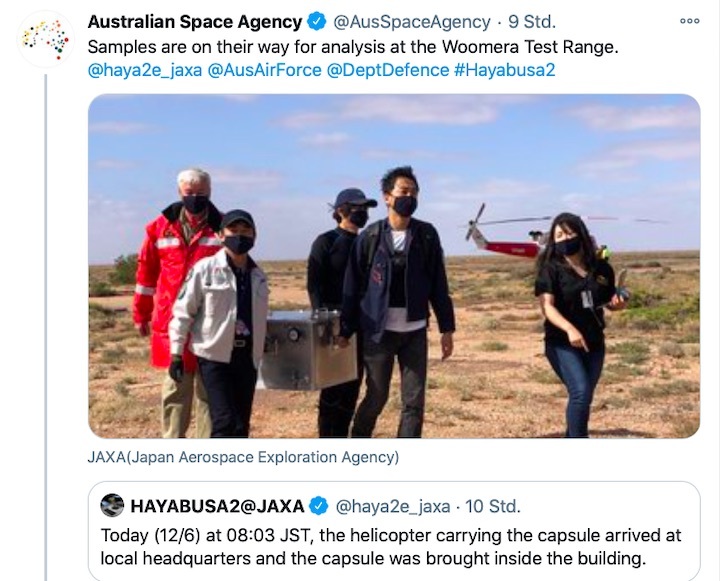
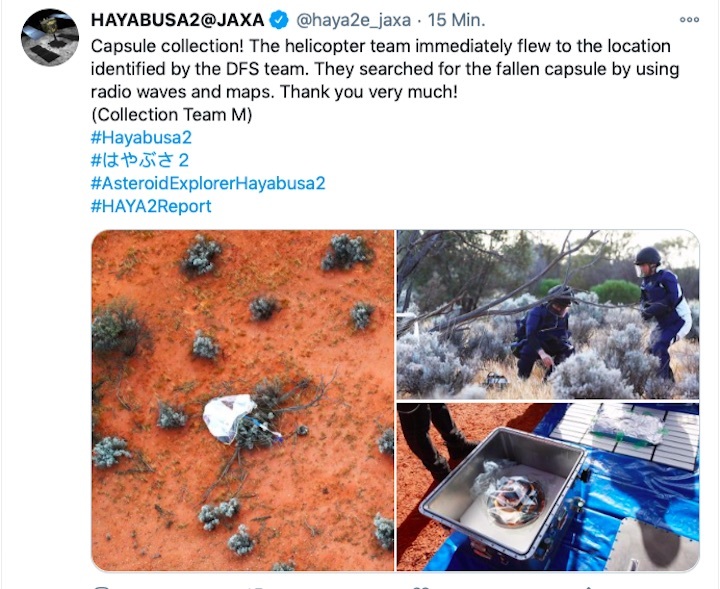
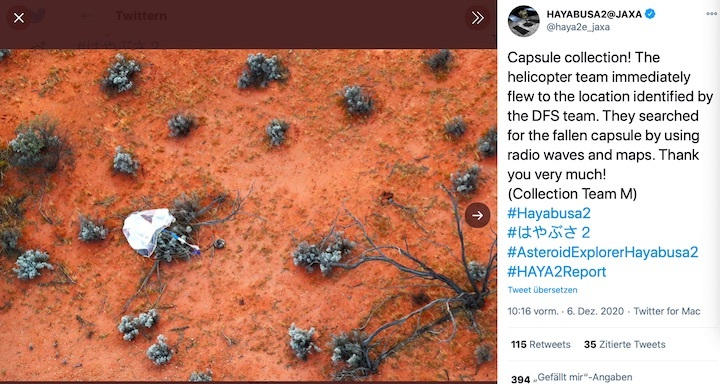
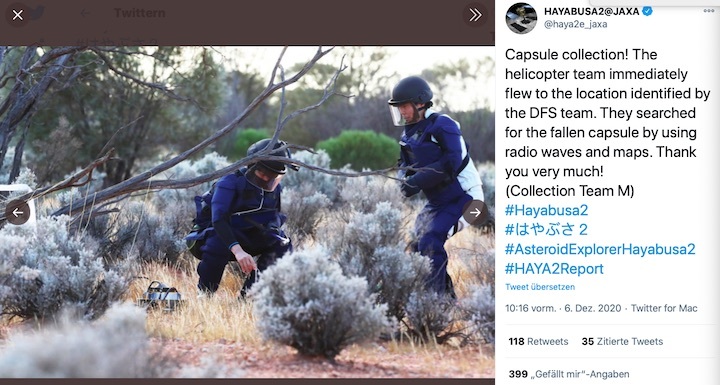
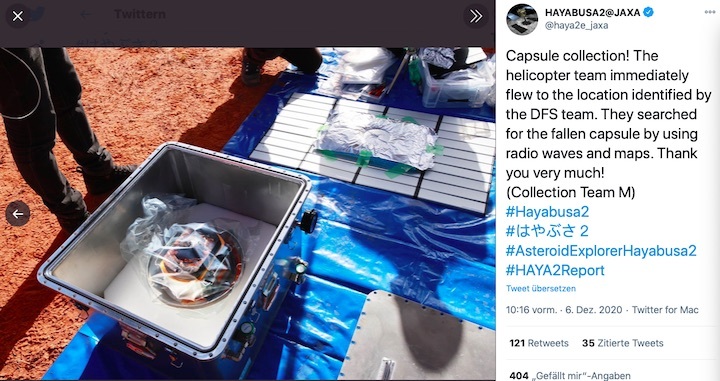
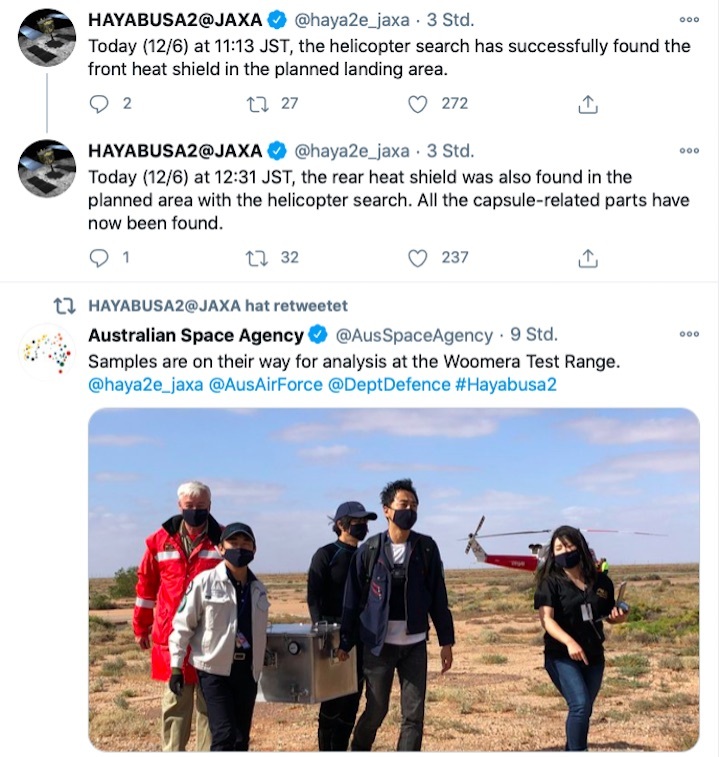
Quelle: Twitter, JAXA
+++
Hayabusa2 capsule retrieved
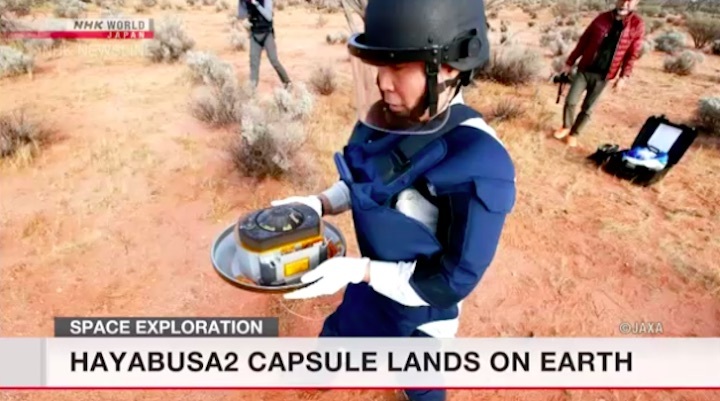
Japan's space agency JAXA has retrieved a capsule released from its asteroid probe Hayabusa2.
The agency said the capsule left a fireball, like a shooting star with a long trail of light, in the skies over Australia.
JAXA officials said the capsule was spotted in a desert in southern Australia by a helicopter on a search flight.
Hayabusa2 released the capsule believed to contain sand samples from the remote asteroid Ryugu on Saturday Japan time.
The capsule was observed as a fireball at around 2:30 a.m. on Sunday, Japan time, or at around 4:00 a.m. local time in South Australia.
Cheers broke out at JAXA's control room in Sagamihara City near Tokyo when the fireball was observed.
The capsule opened its parachute at an altitude of about ten kilometers and landed in the desert area. It was discovered by a helicopter shortly before 5 a.m. Japan time, or before 6:30 a.m. local time. The capsule will now be flown to Japan.
The project manager, Tsuda Yuichi, said in JAXA's streaming program that he is pleased at the return of the capsule. He added he is now relaxed and being briefed by a team retrieving the capsule.
Tsuda said that he and his team members were excited to see the capsule's beautiful re-entry.
The 5-billion-kilometer voyage to and from Ryugu that took six years has come to an end. Hayabusa2 is now heading for another asteroid on a new mission. It is expected to arrive there in 11 years.
Quelle: NHK

